Cite this document
(“The Unity of the Old and New Testament Essay Example | Topics and Well Written Essays - 3000 words”, n.d.)
Retrieved from https://studentshare.org/religion-and-theology/1489327-the-unity-of-the-old-and-new-testament
Retrieved from https://studentshare.org/religion-and-theology/1489327-the-unity-of-the-old-and-new-testament
(The Unity of the Old and New Testament Essay Example | Topics and Well Written Essays - 3000 Words)
https://studentshare.org/religion-and-theology/1489327-the-unity-of-the-old-and-new-testament.
https://studentshare.org/religion-and-theology/1489327-the-unity-of-the-old-and-new-testament.
“The Unity of the Old and New Testament Essay Example | Topics and Well Written Essays - 3000 Words”, n.d. https://studentshare.org/religion-and-theology/1489327-the-unity-of-the-old-and-new-testament.


